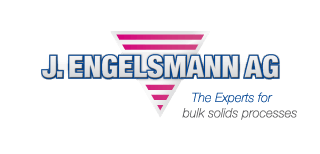System technology for a viscous product
The handling of complicated products, restricted space on site, delivery from a single supplier, comprehensive knowledge and experience in the field of process engineering as well as the plant qualification - these are only a few of the skills a modern supplier of individual components and complete systems must have. J. Engelsmann AG is happy to take on these requirements and finds solution proposals for the benefit of our customers. After all we look back on a company history of more than 135 years.
J. Engelsmann AG - your expert in the field of process engineering -was asked to supply one of our customers with a plant that in addition to the plant and control engineering also included the corre-sponding qualifications.
The essential task of the customer was to homogenise a product on site (very fine – smaller than 10 my and with a bad flow), subsequently implement a dosed control sieving and then fill the material in 30 l containers (with inserted inliners) and finally seal these units. One of the challenges was the very low ceiling height on site.
Additionally, the plant had to fully comply with the requirements of GMP. This also set high demands for the issue of cleaning. Naturally, the complete electrical control as well as the assembly on site were part of the scope of delivery so that the plant was supplied turnkey-ready. Parallel to the project we also implemented the plant qualification required for production according to GMP (DQ, FAT and in terms of the SAT on site also IQ and OQ).
The problem was solved with the following plant layout:
A cone ribbon mixer characterised by a quick and gentle mixing operation was used for the mixing. Another important feature is the almost complete emptying of materials. This is achieved by the very good wall effect of the mixer. From here the product is transported by means of a rotary feeder (incl. slide device of the rotary wheel – new type series EZS) to the control sieving. This type of rotary feeder distinguishes itself through the high variability. It is very easy to equip the rotary feeder at a later point with e.g. an extractor device (slight loosening of the wheel from the housing due to product residuals) or with a slide device (guidance at the pullout of the rotary wheel). The sieving process is then implemented on a cylindrical sieving machine of the type series JEL-Fix 50, equipped with a sieve cleaning by means of ultrasound. This sieving machine offers easy handling and a very compact construction. After the sieving process, the customer can optionally implement a sampling to document the quality of the product. Further down the line on site, the containers including the inliners will be filled and sealed. This is carried out using a filling stand with an integrated filling head, which has a double-pipe design with an exhaust air vent mounted on the site (for the outlet of the sup-pressed air). The inliners are tied to the filling head using an inflatable seal which enables a dust-free filling. The sealing process occurs immediately after the filling. The special characteristic of the sealing device is that it can seal both PE bags and aluminium laminated inliners. Additionally, it is equipped with a suction lance to remove the remaining air prior to sealing the product.
Therefore the main components are:
- cone ribbon mixer with 750 l effective volume
- rotary valve with slide device
- circular sieving machine with ultrasound cleaning (incl. sampler)
- filling and weighing stand with floor scale and operating panel
- film sealing devices
- roller conveyor
- frame for installation of different plant components
- electrical control
- mechanical and electrical installation as well as commissioning and training
- plant qualification
Parallel to the works a corresponding certification was carried out for the plant. This comprised the following steps:
DQ (Design Qualification)
In this phase, the buyer issued a product requirements document and the contractor issued a func-tional specification. During the DQ both documents were checked for compliance, modifications were discussed and then approved and released for the modification phase.
FAT (Factory Acceptance Test)
In this phase, a test was implemented at Engelsmann that comprised all operating conditions that could be simulated (e.g. mixing, sieving, ...). Furthermore, all peripheral devices were connected pro-visionally (as far as feasible and reasonable). The results were documented.
SAT (Site Acceptance Test)
At the point of delivery to the customer, the plant was checked for compliance with the specifications, integrity and quality. These results were also documented.
IQ (Installation Qualification)
In this phase, documented evidence was produced to ensure that all critical equipment and systems were supplied and installed in accordance with the defined requirements. All important plant parame-ters, control engineering as well as security-related installations were tested for their functionality in a documented dry run (without product).
OQ (Operation Qualification)
This qualification was used to document that the plant works faultless with the product and under real conditions and that the specified values are achieved. Subsequent to this step, the plant was handed over to the customer together with a final report.
And here, once again, a summary of the advantages:
- customised plant for the limited ceiling heights on site
- reduced interfaces (everything from a single source)
- perfect handling thanks to ergonomic design
- easy cleaning due to the construction without clearance volumes
- maintainable construction
- plant qualification from a single source







